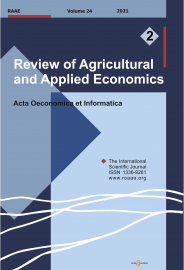KEYWORDS:
membership duration; participatory forest management; generalized propensity score; dose-response function; consumption expenditure
DOI NUMBER:
10.15414/raae.2022.25.01.13-29
ABSTRACT:
Research background: Participatory Forest Management program (PFMP) is initiated to manage forest resources and promote household participation to enhance their livelihood. In contrast, the long-term evaluation of many programs' timing remains low attention. Thus, it is vital to measure livelihood impacts on membership duration associated with the PFM program in Ethiopian farm householdsPurpose of the article: To evaluate the impact of membership duration in participatory forest management on livelihoods of program participating households in south-western Ethiopia. The results of the program's periodic assessment data were analysed on the long-term effect of the activities of forest management members.
Methods: The study applied the generalized propensity score method. The research depends on cross-sectional survey data collected in mid-2018 from 267 farm households from Sheka and Kafa zones of south-western Ethiopia. The procedure matched families with similar covariates with different years of membership duration in the participatory forest management program. The technique was used members' annual per capita expenditure as an indicator outcome variable for measuring rural livelihood.
Findings, value-added & novelty: Impacts studies of PFMP on heterogeneous effects across different groups of membership duration are scarce, and there is a research gap on how membership duration affects outcomes. Our study addresses this gap by measuring the long-term evaluation of program outcomes and their impacts on the participatory member households. Furthermore, the result revealed that the program's effects were initially low but positively affected when approaching an optimum year of membership dose. The program's optimal duration of the membership dose was 11-12 years, and 4263.75 birrs were the optimal level of yearly household per capita consumption spending.
Recommendation: The results recommend more work on the participating household members by encouraging new forest-related income sources and integrating the socio-economic network more closely with the forest's ecosystem services. Although the relationship among participating members of households' longevity and income is substantial, the program has been focused on the medium and longer duration of the forest program participating.
Please Cite this Article as:
Endale DIFABACHEW, Jema HAJI, Belaineh LEGESSE, Mengistu KETEMA (2021) Evaluating Membership Duration In The Participatory Forest Management On Livelihood In Ethiopia: A Generalized Propensity Score Approach. Review of Agricultural and Applied Economics. Advance online publication. doi: 10.15414/raae.2022.25.01.13-29
URL for sharing:
https://roaae.org/1336-9261/doi/abs/10.15414/raae.2022.25.01.13-29
FULL TEXT PDF:
▼ direct download link| view online in fullscreen ▲

